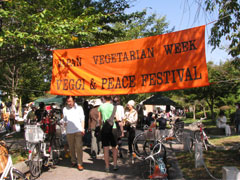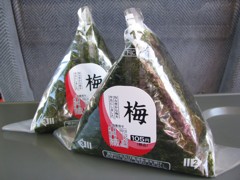… the journal of a South African vegan in Japan
30 November 2009
God bless Italians. Pizza is amazing. Being vegan makes eating pizza a treat, rather than a take-out, but all the more enjoyable for it. The thing with non-dairy cheese is that it’s difficult to find (at least, in Japan) and usually expensive, and the alternatives require a couple of culinary skills. Case in point: cashew cheese. Luckily for me, there is a vegetarian restaurant in Hommachi, central Osaka, which possesses said culinary skills.
 I went for a lazy Saturday lunch at Green Earth (gotta love the name), and ordered their special vegan pizza, drooling with anticipation. It had been 8 months, 2 weeks and 3 days since I last bit into vegan pizza, and I was near breaking point. The restaurant used to make the pizza with soy cheese, but recently changed to cashew. Why, I’m not sure. Anyway, the pizza arrived – a medium crust, topped with brinjals, peppers, olives and pineapple. Metcha oishii, as they say here. That means really delicious. It wasn’t a St Elmo’s style, more like a focaccia, but it went down a treat.
I went for a lazy Saturday lunch at Green Earth (gotta love the name), and ordered their special vegan pizza, drooling with anticipation. It had been 8 months, 2 weeks and 3 days since I last bit into vegan pizza, and I was near breaking point. The restaurant used to make the pizza with soy cheese, but recently changed to cashew. Why, I’m not sure. Anyway, the pizza arrived – a medium crust, topped with brinjals, peppers, olives and pineapple. Metcha oishii, as they say here. That means really delicious. It wasn’t a St Elmo’s style, more like a focaccia, but it went down a treat.
I also ordered a side of battered ‘chicken’ nuggets, made using that gluten meat I blogged about a while back (see Part 4). They were tasty – though could have done with a dipping sauce of sorts – like a sweet chilli sauce or something. And for dessert … there was pumpkin cake with vegan cream. It was definitely the best cake I’ve had in Japan so far. I ordered a second slice for the road. They sell sweet tofu muffins, carob brownies and a few other sweet treats near the till – almost all vegan, and cheap.
In other good news, there has been some resolution with the cats I blogged about last time. I took a trip out to Shiga again, to show a volunteer from the NPO where the cats are. We fed a few of them, and she promised to chat to another volunteer about getting some TNR done. The next day, she mailed me to say that she’d been back to the spot, with the volunteer, and they’d found out that all of the cats but one had in fact already been neutered/spayed by the locals!
The neighbouring residents had taken pity on the cats and trapped them one by one, and some residents had even let the kitties move into their houses. One man apparently has 10 cats in his house. They said that the area is known as a dumping ground for unwanted pets, and they were trying to stop the cat population from increasing by doing TNR. It was very welcome good news! The money I’d set aside for the TNR of those cats, I transferred to the NPO for use on another group of cats, rescued on the other side of the river.
So, there’s hope out there, it seems.
 Pick a park, any park, poke around in the bushes a little, and you’re bound to find a full-on feral cat colony. Sometimes you won’t even need to look – the cats will caterwaul and come find you, in the hopes of scraps of food. The number of cats that have been abandoned over the years, and bred out in parks, gutters and other areas around cities, is heartbreaking. There are a couple of excellent NPOs working for these kitties; but they’ve really got their work cut out for them.
Pick a park, any park, poke around in the bushes a little, and you’re bound to find a full-on feral cat colony. Sometimes you won’t even need to look – the cats will caterwaul and come find you, in the hopes of scraps of food. The number of cats that have been abandoned over the years, and bred out in parks, gutters and other areas around cities, is heartbreaking. There are a couple of excellent NPOs working for these kitties; but they’ve really got their work cut out for them. Finding organic soil proved near-impossible. We asked around, in English and Japanese, to no avail. It was either sift through the bags of soil at the nurseries to find a brand with the least fertilisers and other added chemicals, or dig up the local park. The latter posed 2 problems: 1, the risk of getting caught and having to deal with authorities in extremely limited Japanese; and 2, the fact that the soil is compact and very clay-like. We had already acquired 4 pots of this clay-like soil from a construction site down the road (another story altogether). So we opted for the nursery soil. Organic soil is just not one of the conveniences in super-convenient Osaka.
Finding organic soil proved near-impossible. We asked around, in English and Japanese, to no avail. It was either sift through the bags of soil at the nurseries to find a brand with the least fertilisers and other added chemicals, or dig up the local park. The latter posed 2 problems: 1, the risk of getting caught and having to deal with authorities in extremely limited Japanese; and 2, the fact that the soil is compact and very clay-like. We had already acquired 4 pots of this clay-like soil from a construction site down the road (another story altogether). So we opted for the nursery soil. Organic soil is just not one of the conveniences in super-convenient Osaka.  Add some flowers, a rescued hibiscus tree and some organic lavender to the mix and our balcony garden is coming along nicely. Oh, not to mention a cotton tree … never mind vegan veggie gardening –it’s time to take this to the next level – my sidekick has threatened to start weaving her own clothes.
Add some flowers, a rescued hibiscus tree and some organic lavender to the mix and our balcony garden is coming along nicely. Oh, not to mention a cotton tree … never mind vegan veggie gardening –it’s time to take this to the next level – my sidekick has threatened to start weaving her own clothes. There were a handful of gaijin (foreigners), and a lot of Japanese folk of all ages at the buffet. There were even some cute vegan kids running around, munching away and giggling under the tablecloths. The dinner was about exchanging stories, but the big veg fest itself was about showing people how easy it is to be vegetarian or vegan, and why it’s so important that we go flesh-free. We all had to say a few lines on why we were vegan – I could only manage English, but I mentioned environmental, animal and, oft-forgotten, human rights reasons.
There were a handful of gaijin (foreigners), and a lot of Japanese folk of all ages at the buffet. There were even some cute vegan kids running around, munching away and giggling under the tablecloths. The dinner was about exchanging stories, but the big veg fest itself was about showing people how easy it is to be vegetarian or vegan, and why it’s so important that we go flesh-free. We all had to say a few lines on why we were vegan – I could only manage English, but I mentioned environmental, animal and, oft-forgotten, human rights reasons. I just missed Golden Week; being, at that point, in South Africa, and running around like mad to get ready for my move East. Silver Week, however, I was lucky enough to be here for. I marked it in my diary as soon as I touched down in Tokyo. Partner and 2 friends in tow, I headed to the north of the neighbouring prefecture of Wakayama (the south part of which is where the annual dolphin slaughter happens, fyi), to a mountainous village known as Koya-San.
I just missed Golden Week; being, at that point, in South Africa, and running around like mad to get ready for my move East. Silver Week, however, I was lucky enough to be here for. I marked it in my diary as soon as I touched down in Tokyo. Partner and 2 friends in tow, I headed to the north of the neighbouring prefecture of Wakayama (the south part of which is where the annual dolphin slaughter happens, fyi), to a mountainous village known as Koya-San. Onigiri, as they’re known in Japanese, are little triangles of super-processed rice, with a strip of seaweed around the outside, and a bit of filling. Most contain fish, but there are almost always pickled plum (ume) and kelp (kombu) options for us vegans. The filling is written in kanji on the front. No problem, I thought, because the packets are colour-coded too. At Lawsons (a huge chain of konbinis; they even appear as landmarks on Google Maps), purple means plum and green means seaweed. Unfortunately, at other stores (there are about 4 other major chains – 7/11, FamilyMart, am/pm and Sunkist), green also means fish, and I had the unpleasant experience of biting into a rice ball and staring into the eyes of about 100 tiny, dead fish. Moral of the story? Learn kanji, and bite with caution!
Onigiri, as they’re known in Japanese, are little triangles of super-processed rice, with a strip of seaweed around the outside, and a bit of filling. Most contain fish, but there are almost always pickled plum (ume) and kelp (kombu) options for us vegans. The filling is written in kanji on the front. No problem, I thought, because the packets are colour-coded too. At Lawsons (a huge chain of konbinis; they even appear as landmarks on Google Maps), purple means plum and green means seaweed. Unfortunately, at other stores (there are about 4 other major chains – 7/11, FamilyMart, am/pm and Sunkist), green also means fish, and I had the unpleasant experience of biting into a rice ball and staring into the eyes of about 100 tiny, dead fish. Moral of the story? Learn kanji, and bite with caution! I also visited a really “rad” vegan restaurant in Hommachi, which is about 40 minutes from my flat, easily accessible on the train lines. It’s called Raku (’Luck’) Café, and it’s what locals call a “hole-in-the-wall” – a tiny place with a counter and seats for at most, 6 people. The owner is vegan and really chilled. I’d read about his restaurant on
I also visited a really “rad” vegan restaurant in Hommachi, which is about 40 minutes from my flat, easily accessible on the train lines. It’s called Raku (’Luck’) Café, and it’s what locals call a “hole-in-the-wall” – a tiny place with a counter and seats for at most, 6 people. The owner is vegan and really chilled. I’d read about his restaurant on 